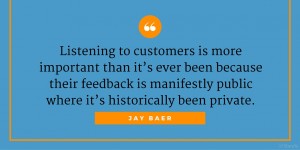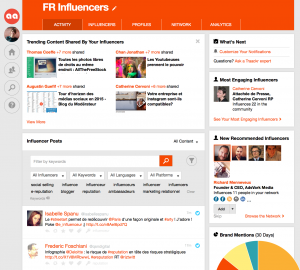We can all agree that data-driven marketing (DDM) has crossed the line from being a sleek, sophisticated nice-to-have to being a true marketing imperative. By leveraging customer data, brands can deliver more meaningful, more relevant experiences at scale; deepen relationships; drive incremental engagement and action; and ultimately, create levels of long-term loyalty and advocacy that separate the good from the great. It’s a total gamechanger in any vertical — and, it’s here to stay.
However, while I’m in support of harnessing the power of data to drive superior, customer-led experiences, there still appear to be some decidedly gray areas in the mix. And, oftentimes, those gray areas seem to be tied to the creative process. It makes sense — creative brand content has always had its own parameters. But, now that DDM is more or less the universal mandate, where’s the line? Is data now the be-all and end-all decision maker for customer experiences, including creative touchpoints, or is there a give-and-take that ensures a smart, strategic balance between the two? Further, is this desire for data-driven experiences hindering the creative process as well as content performance — and, if not now, could it down the line?
The Power of Dynamic Creative Optimization
Enter dynamic creative optimization (DCO) — the process that enables brands to use data-driven advertising at scale with redefined creative parameters designed specifically for those ads. Under the DCO umbrella, custom ad creative gives way to custom ad layouts or templates, facilitating broader creativity that’s always underscored by data. Creatives have the space they need to create, but — because ads leverage a set ad layout with dynamic elements — marketers can ensure they’re still wholly data driven, and thus, driving maximum ad effectiveness.
One of the biggest design-focused perks is that DCO removes some of the mundanity from dynamic-ad creation. Let’s say, for example, you’re a travel brand that wants to personalize your digital ads by weaving targeted destination cities throughout the campaign. So, if someone were to search for Seattle, your ad would include a prominent Seattle callout. Changing the travel city isn’t particularly exciting for a designer, pulling them away from more creative tasks, but it’s still very important to the success of your campaign.
And, that’s just a small example. Imagine you’re a retailer with 50,000 product SKUs, and you want your ads to be personalized to display the actual products a consumer is interested in. That could — quite literally — meanmillions of potential combinations of products and creative elements. It’s impossible for a designer to shoulder a task like that, but with DCO, a designer can easily create an ad layout and set the dynamic-optimization wheels in motion. Consumers see the right creative content at the precise time, driven by data and supported by the designer. It’s a strong balance that delivers strong results.
The Dynamic Potential
While DCO is primarily used for retargeting campaigns nowadays, infinite possibilities exist for brands and creatives to expand their views of what dynamic creative can do. Done right, DCO can extend across the entire marketing funnel — from personalized experiences and loyalty programs to new-customer acquisition and awareness initiatives. Designers can really dig in, updating ad layouts and creating more personalized experiences for individual audiences — much greater than simply swapping ‘sneakers’ for ‘lightbulbs’ or ‘Seattle’ for ‘New York’.
For example, let’s say that you know User A was just shopping for skis. With DCO in place, you can now do something really cool with that intel — maybe upsell or cross-sell her helmets, ski clothing, or vacation packages as she surfs the web.
But, it doesn’t stop there. The more data you have, the more possibilities you have. So, perhaps, you want to create a “high-intent ski-buyer” segment with an ad layout to support it. By integrating Adobe Analytics, you can segment audiences like this and use those segments to trigger specific ad layouts.
The same applies for data management. Adobe Audience Manager can take an audience segment and use it to inform or trigger an ad layout in DCO. You can even layer on third-party data — lifestyle interests, demographics, and business attributes, for example — creating even more-robust audience segments and even tighter creative messaging. So, maybe you know that the skier researched expensive skis and — based on third-party data — that she’s an avid traveler who buys a ski pass for a nearby resort every season.
To upsell her, you’ll have your templates and layouts that will weave in real-time recommendations and relevance based on her latest movements — and those ads will look and feel much different from ads you show casual hobbyists or first-timers. The layout experience will change based on the audience — with DCO driving hyper-personalization.
Granted, this endless potential can feel a little overwhelming, especially for organizations with less data maturity. So many opportunities can cause marketers to fall into action paralysis much more easily — instead of making decisions, they just choose not to choose. It’s a very real risk that companies need to be mindful of from the beginning. Advertising and analytics teams must be in sync with creatives from day one, working together and focusing on the data — what they have available, what they can use in advertising, and what technologies and systems tie it all together.
By taking stock of the data and working through a typical customer journey, you’ll be better prepared to think cross-funnel and identify the optimal experiences needed. Maybe you only need one ad experience, maybe you need 10 — or maybe you need 100, driving tens of thousands of combinations of creative elements and product messages. Just deciding where you need to land will help your designer determine where to take the ad layouts.
Considerations for Creatives
But, like anything, DCO comes with a host of considerations and tradeoffs. For designers and creatives, the biggest — hands down — is flexibility. Generally, static ads are easier to develop and push out into the market and tend to be less vulnerable and have fewer functionality issues — unsurprising, since static ads have fewer moving parts than dynamic ads do.
That said, static ads tend to tie back to lowest common-denominator messaging. When you use dynamic ads, you have more choices about what to say and how to say it. If a customer is interested in a wide range of products or offers, that can be a real win. However, show one product or message, and you’ll most likely miss the mark with a good chunk of your addressable audience in addition to the potential performance lift. One retail advertiser (and Adobe customer) using DCO experienced an 81 percent higher conversion rate and a 73 percent increase in engagement (click-through rate) versus standard display ads for retargeting. Using DCO to retarget consumers who abandoned the payment page resulted in a 400 percent higher conversion rate!
DCO’s dynamic templates give creatives and designers the ability to present multiple messages, offers, and value propositions based on the data-driven profile of each consumer. DCO facilitates messaging that’s much closer to a 1:1 approach versus the one-size-fits-all approach that static ads provide. Relevance and flexibility increase, time to market decreases — and still, designers can flex their creative muscles more than they can with DDM-centric ads.
Preparing for the Future of DCO
DCO is no longer just for retail and travel advertisers, and its opportunities have expanded beyond retargeting. Now, it’s for all verticals in which granular audiences exist, and it can be used in loyalty programs and for customer acquisition, upselling, cross-selling, and retargeting.
Take the auto industry, for example, in which both potential and existing customers research dealers and customizations. Here, upselling and cross-selling are often welcomed. Likewise, in the financial-service industry, potential customers look for personalized credit-card offers that will meet their reward and rate requirements. In both verticals, advertisers can create lucrative and long-term loyalty by offering exactly what the customer wants, regardless of his or her place in the customer journey. This means that brands are increasingly competing with regard to advertising personalization. In DCO, the marriage of analytics and creative allows for deeper-than-ever ad-layout personalization. But, organizations must be prepared to deliver.
As more and more advertisers in all verticals adopt dynamic creative for cross-funnel use, teams will need to band together more closely — and that means eliminating the silos that tend to separate these core stakeholders. Data and analytics teams need to be in-step regarding that data and the audiences that can be built with it. Advertising teams must have a robust strategy that extends across the entire funnel and into the different programs, campaigns, and initiatives. Designers should work with everyone to generate the right creative for these audiences. And everyone needs to understand a few key details such as what the customer journey actually looks like, where customers need to be delivered, and ultimately, what kinds of experiences will move customers through the marketing funnel and into the conversion zone. It’s about collaboration — plain and simple. Is it already happening? Absolutely — but we’ll need to see even more of it for DCO to reach its full potential.
Digital & Social Articles on Business 2 Community(36)








